Customer Behavior and Marketing Strategies of Vodafone Group
VerifiedAdded on 2023/04/21
|16
|3981
|447
Report
AI Summary
This report provides an in-depth analysis of Vodafone Group Plc's customer behavior and marketing strategies, utilizing a PESTLE analysis to examine the socio-cultural and macro-environmental factors influencing the company's global business. It explores the impact of political, economic, social, technological, environmental, and legal factors on Vodafone's operations, highlighting their effects on consumer purchase decisions and brand switching processes. Furthermore, the report evaluates Vodafone's marketing mix through the 4Ps of marketing (Product, Price, Place, Promotion) and the Market Segmentation Theory, suggesting strategies for marketing improvement. The analysis considers Vodafone's expansion into markets like the UK, Australia, the Middle East, and Asia, and how factors such as broadband speed, demographic trends, tariff rates, and technological advancements have influenced its market position and customer acquisition.
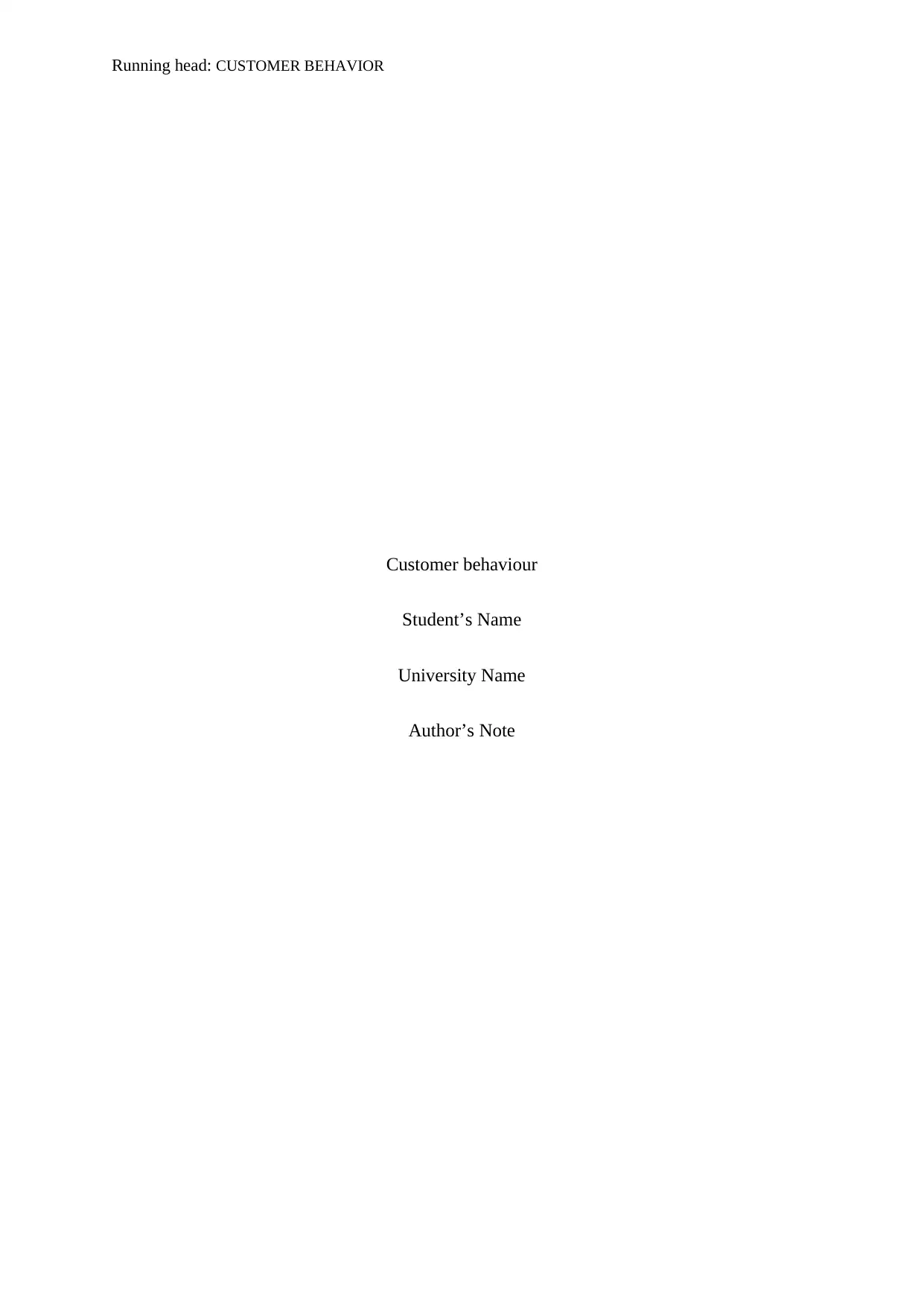
Running head: CUSTOMER BEHAVIOR
Customer behaviour
Student’s Name
University Name
Author’s Note
Customer behaviour
Student’s Name
University Name
Author’s Note
Paraphrase This Document
Need a fresh take? Get an instant paraphrase of this document with our AI Paraphraser
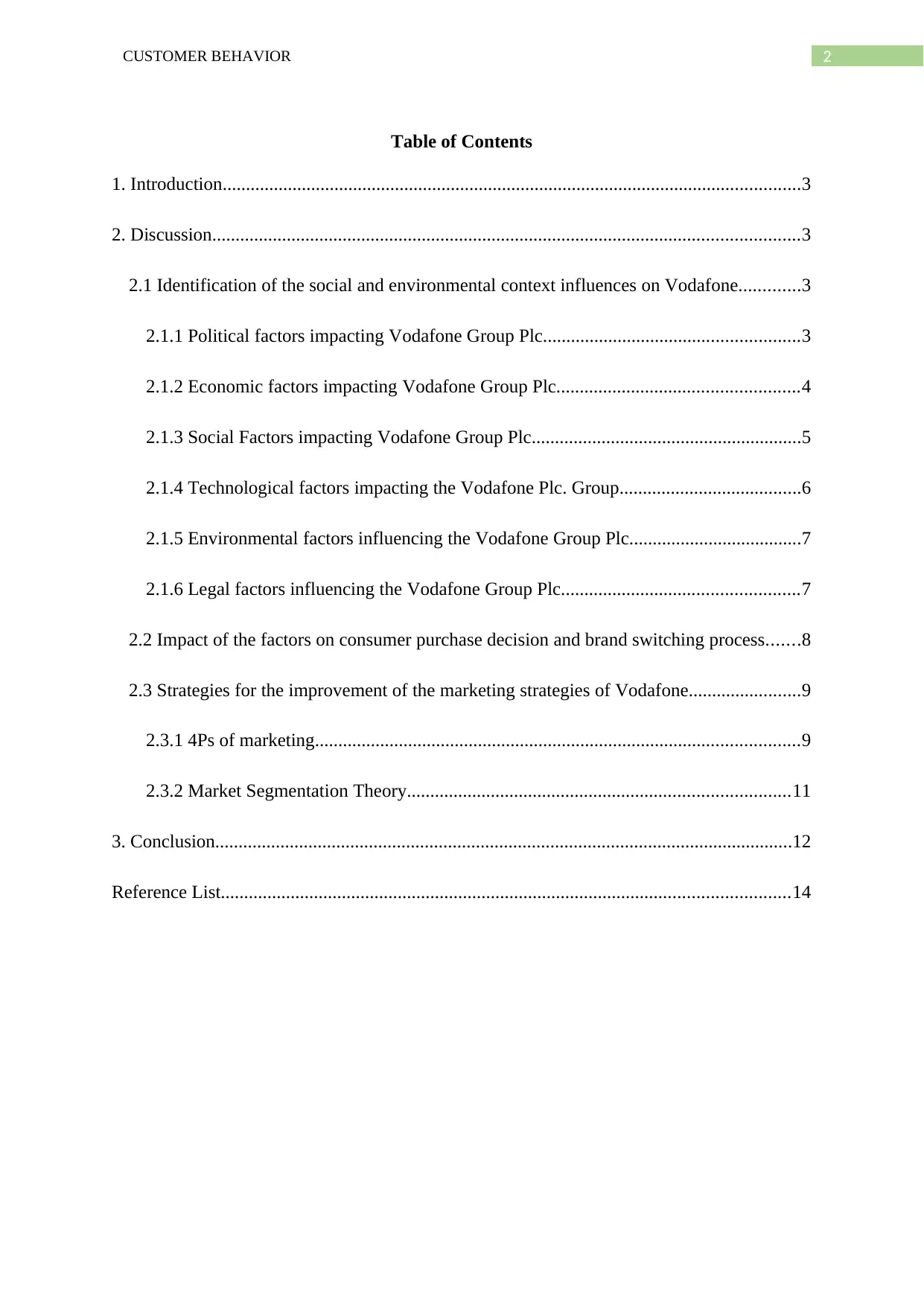
2CUSTOMER BEHAVIOR
Table of Contents
1. Introduction............................................................................................................................3
2. Discussion..............................................................................................................................3
2.1 Identification of the social and environmental context influences on Vodafone.............3
2.1.1 Political factors impacting Vodafone Group Plc.......................................................3
2.1.2 Economic factors impacting Vodafone Group Plc....................................................4
2.1.3 Social Factors impacting Vodafone Group Plc..........................................................5
2.1.4 Technological factors impacting the Vodafone Plc. Group.......................................6
2.1.5 Environmental factors influencing the Vodafone Group Plc.....................................7
2.1.6 Legal factors influencing the Vodafone Group Plc...................................................7
2.2 Impact of the factors on consumer purchase decision and brand switching process.......8
2.3 Strategies for the improvement of the marketing strategies of Vodafone........................9
2.3.1 4Ps of marketing........................................................................................................9
2.3.2 Market Segmentation Theory..................................................................................11
3. Conclusion............................................................................................................................12
Reference List..........................................................................................................................14
Table of Contents
1. Introduction............................................................................................................................3
2. Discussion..............................................................................................................................3
2.1 Identification of the social and environmental context influences on Vodafone.............3
2.1.1 Political factors impacting Vodafone Group Plc.......................................................3
2.1.2 Economic factors impacting Vodafone Group Plc....................................................4
2.1.3 Social Factors impacting Vodafone Group Plc..........................................................5
2.1.4 Technological factors impacting the Vodafone Plc. Group.......................................6
2.1.5 Environmental factors influencing the Vodafone Group Plc.....................................7
2.1.6 Legal factors influencing the Vodafone Group Plc...................................................7
2.2 Impact of the factors on consumer purchase decision and brand switching process.......8
2.3 Strategies for the improvement of the marketing strategies of Vodafone........................9
2.3.1 4Ps of marketing........................................................................................................9
2.3.2 Market Segmentation Theory..................................................................................11
3. Conclusion............................................................................................................................12
Reference List..........................................................................................................................14
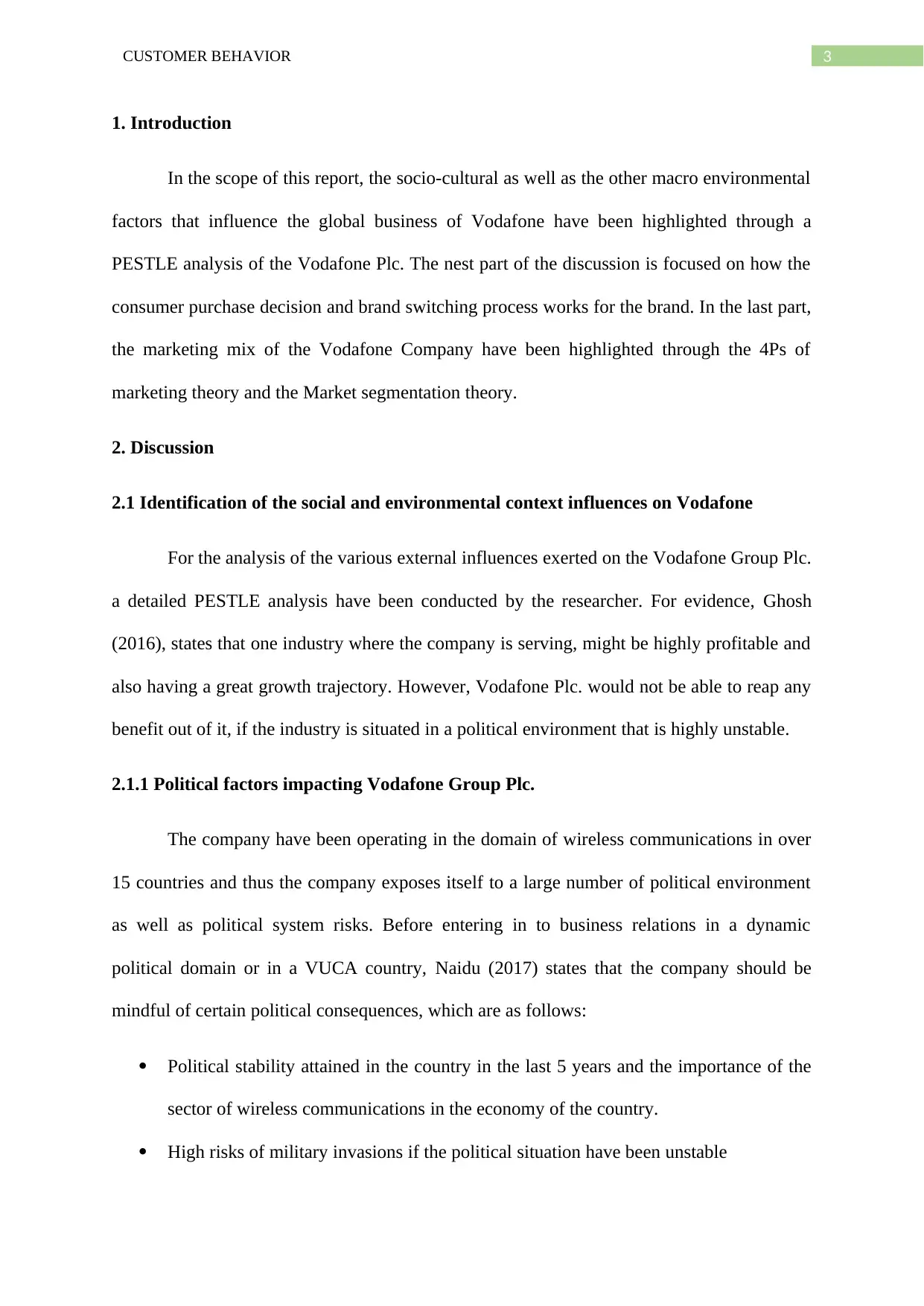
3CUSTOMER BEHAVIOR
1. Introduction
In the scope of this report, the socio-cultural as well as the other macro environmental
factors that influence the global business of Vodafone have been highlighted through a
PESTLE analysis of the Vodafone Plc. The nest part of the discussion is focused on how the
consumer purchase decision and brand switching process works for the brand. In the last part,
the marketing mix of the Vodafone Company have been highlighted through the 4Ps of
marketing theory and the Market segmentation theory.
2. Discussion
2.1 Identification of the social and environmental context influences on Vodafone
For the analysis of the various external influences exerted on the Vodafone Group Plc.
a detailed PESTLE analysis have been conducted by the researcher. For evidence, Ghosh
(2016), states that one industry where the company is serving, might be highly profitable and
also having a great growth trajectory. However, Vodafone Plc. would not be able to reap any
benefit out of it, if the industry is situated in a political environment that is highly unstable.
2.1.1 Political factors impacting Vodafone Group Plc.
The company have been operating in the domain of wireless communications in over
15 countries and thus the company exposes itself to a large number of political environment
as well as political system risks. Before entering in to business relations in a dynamic
political domain or in a VUCA country, Naidu (2017) states that the company should be
mindful of certain political consequences, which are as follows:
Political stability attained in the country in the last 5 years and the importance of the
sector of wireless communications in the economy of the country.
High risks of military invasions if the political situation have been unstable
1. Introduction
In the scope of this report, the socio-cultural as well as the other macro environmental
factors that influence the global business of Vodafone have been highlighted through a
PESTLE analysis of the Vodafone Plc. The nest part of the discussion is focused on how the
consumer purchase decision and brand switching process works for the brand. In the last part,
the marketing mix of the Vodafone Company have been highlighted through the 4Ps of
marketing theory and the Market segmentation theory.
2. Discussion
2.1 Identification of the social and environmental context influences on Vodafone
For the analysis of the various external influences exerted on the Vodafone Group Plc.
a detailed PESTLE analysis have been conducted by the researcher. For evidence, Ghosh
(2016), states that one industry where the company is serving, might be highly profitable and
also having a great growth trajectory. However, Vodafone Plc. would not be able to reap any
benefit out of it, if the industry is situated in a political environment that is highly unstable.
2.1.1 Political factors impacting Vodafone Group Plc.
The company have been operating in the domain of wireless communications in over
15 countries and thus the company exposes itself to a large number of political environment
as well as political system risks. Before entering in to business relations in a dynamic
political domain or in a VUCA country, Naidu (2017) states that the company should be
mindful of certain political consequences, which are as follows:
Political stability attained in the country in the last 5 years and the importance of the
sector of wireless communications in the economy of the country.
High risks of military invasions if the political situation have been unstable
⊘ This is a preview!⊘
Do you want full access?
Subscribe today to unlock all pages.

Trusted by 1+ million students worldwide
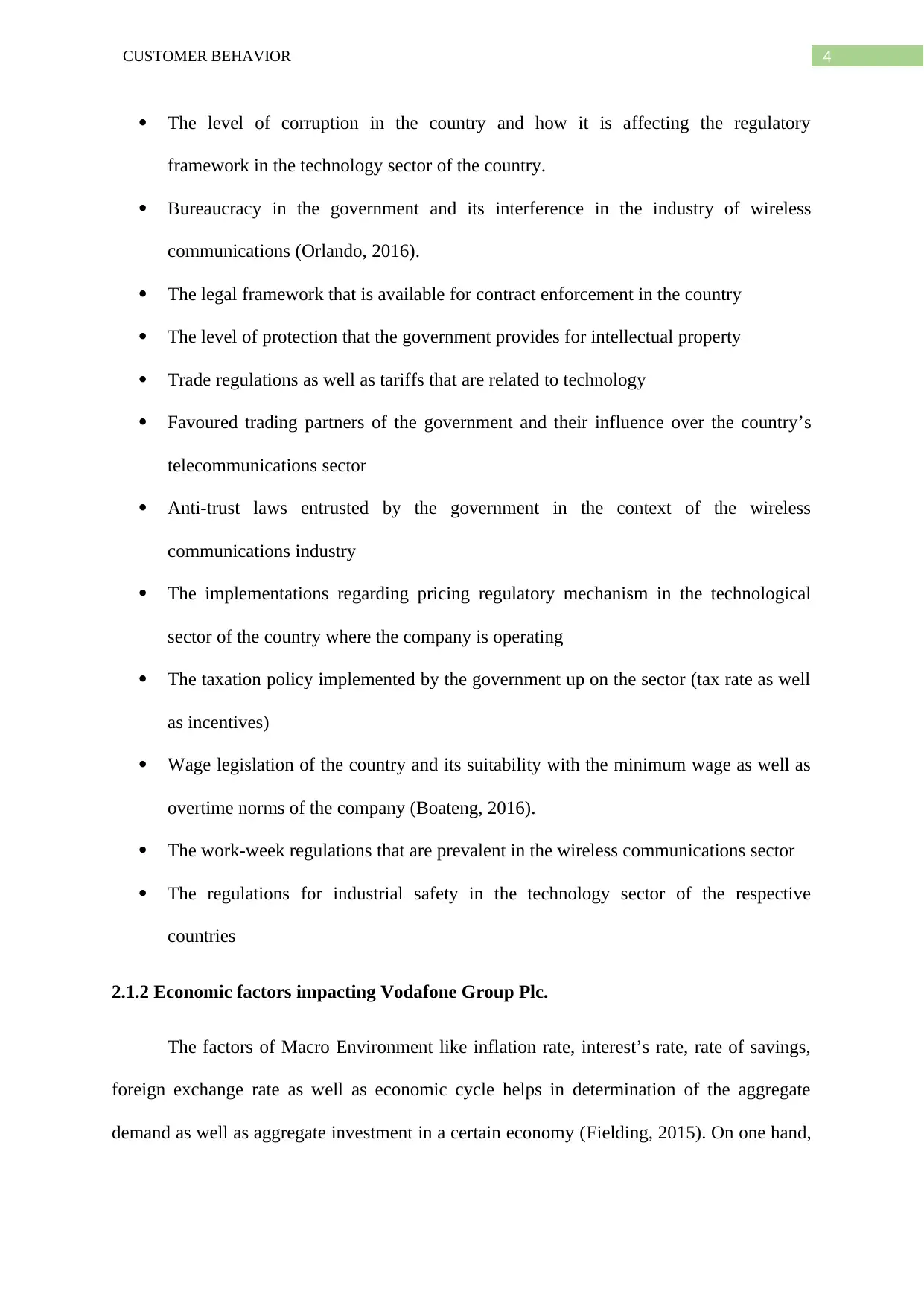
4CUSTOMER BEHAVIOR
The level of corruption in the country and how it is affecting the regulatory
framework in the technology sector of the country.
Bureaucracy in the government and its interference in the industry of wireless
communications (Orlando, 2016).
The legal framework that is available for contract enforcement in the country
The level of protection that the government provides for intellectual property
Trade regulations as well as tariffs that are related to technology
Favoured trading partners of the government and their influence over the country’s
telecommunications sector
Anti-trust laws entrusted by the government in the context of the wireless
communications industry
The implementations regarding pricing regulatory mechanism in the technological
sector of the country where the company is operating
The taxation policy implemented by the government up on the sector (tax rate as well
as incentives)
Wage legislation of the country and its suitability with the minimum wage as well as
overtime norms of the company (Boateng, 2016).
The work-week regulations that are prevalent in the wireless communications sector
The regulations for industrial safety in the technology sector of the respective
countries
2.1.2 Economic factors impacting Vodafone Group Plc.
The factors of Macro Environment like inflation rate, interest’s rate, rate of savings,
foreign exchange rate as well as economic cycle helps in determination of the aggregate
demand as well as aggregate investment in a certain economy (Fielding, 2015). On one hand,
The level of corruption in the country and how it is affecting the regulatory
framework in the technology sector of the country.
Bureaucracy in the government and its interference in the industry of wireless
communications (Orlando, 2016).
The legal framework that is available for contract enforcement in the country
The level of protection that the government provides for intellectual property
Trade regulations as well as tariffs that are related to technology
Favoured trading partners of the government and their influence over the country’s
telecommunications sector
Anti-trust laws entrusted by the government in the context of the wireless
communications industry
The implementations regarding pricing regulatory mechanism in the technological
sector of the country where the company is operating
The taxation policy implemented by the government up on the sector (tax rate as well
as incentives)
Wage legislation of the country and its suitability with the minimum wage as well as
overtime norms of the company (Boateng, 2016).
The work-week regulations that are prevalent in the wireless communications sector
The regulations for industrial safety in the technology sector of the respective
countries
2.1.2 Economic factors impacting Vodafone Group Plc.
The factors of Macro Environment like inflation rate, interest’s rate, rate of savings,
foreign exchange rate as well as economic cycle helps in determination of the aggregate
demand as well as aggregate investment in a certain economy (Fielding, 2015). On one hand,
Paraphrase This Document
Need a fresh take? Get an instant paraphrase of this document with our AI Paraphraser
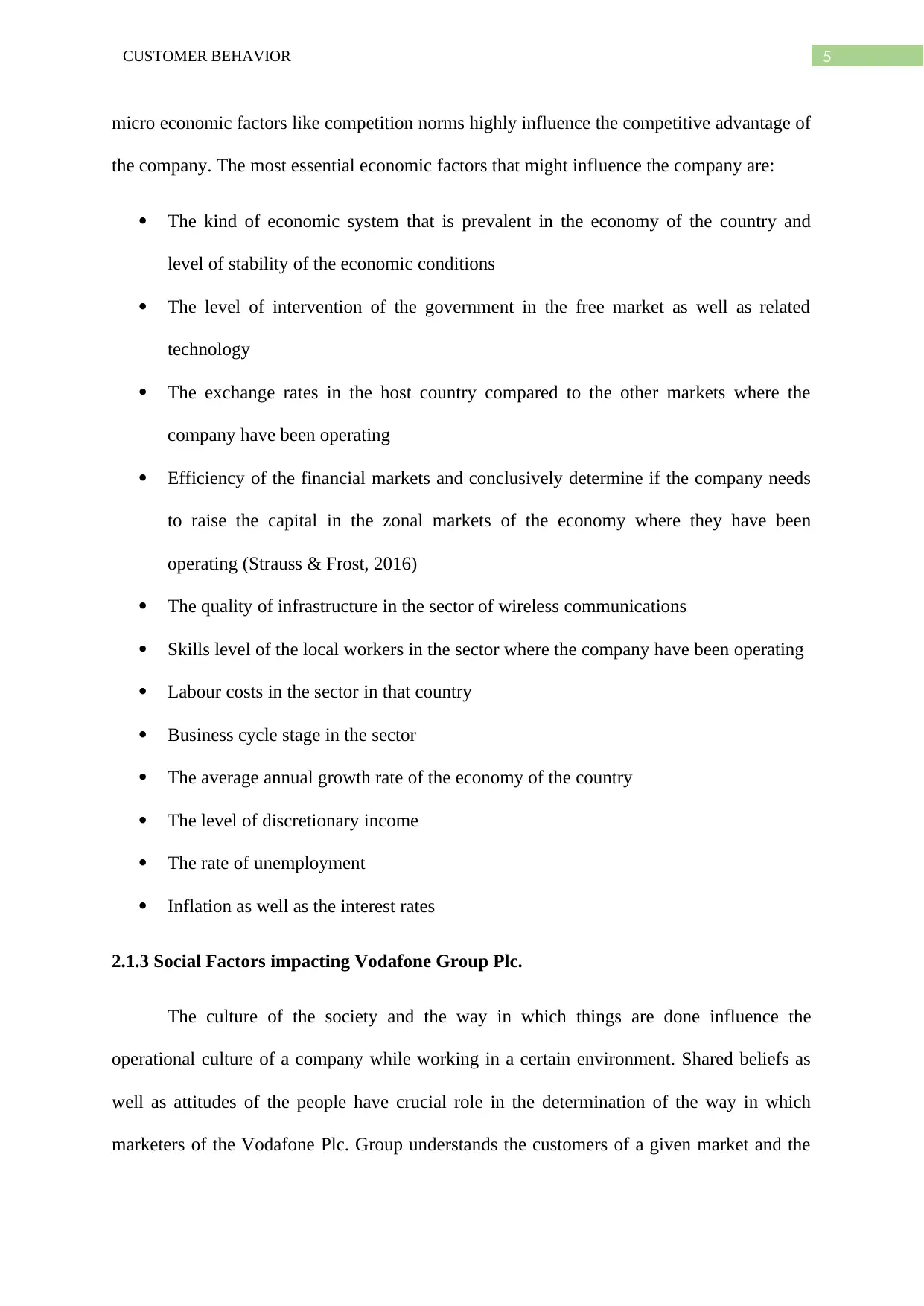
5CUSTOMER BEHAVIOR
micro economic factors like competition norms highly influence the competitive advantage of
the company. The most essential economic factors that might influence the company are:
The kind of economic system that is prevalent in the economy of the country and
level of stability of the economic conditions
The level of intervention of the government in the free market as well as related
technology
The exchange rates in the host country compared to the other markets where the
company have been operating
Efficiency of the financial markets and conclusively determine if the company needs
to raise the capital in the zonal markets of the economy where they have been
operating (Strauss & Frost, 2016)
The quality of infrastructure in the sector of wireless communications
Skills level of the local workers in the sector where the company have been operating
Labour costs in the sector in that country
Business cycle stage in the sector
The average annual growth rate of the economy of the country
The level of discretionary income
The rate of unemployment
Inflation as well as the interest rates
2.1.3 Social Factors impacting Vodafone Group Plc.
The culture of the society and the way in which things are done influence the
operational culture of a company while working in a certain environment. Shared beliefs as
well as attitudes of the people have crucial role in the determination of the way in which
marketers of the Vodafone Plc. Group understands the customers of a given market and the
micro economic factors like competition norms highly influence the competitive advantage of
the company. The most essential economic factors that might influence the company are:
The kind of economic system that is prevalent in the economy of the country and
level of stability of the economic conditions
The level of intervention of the government in the free market as well as related
technology
The exchange rates in the host country compared to the other markets where the
company have been operating
Efficiency of the financial markets and conclusively determine if the company needs
to raise the capital in the zonal markets of the economy where they have been
operating (Strauss & Frost, 2016)
The quality of infrastructure in the sector of wireless communications
Skills level of the local workers in the sector where the company have been operating
Labour costs in the sector in that country
Business cycle stage in the sector
The average annual growth rate of the economy of the country
The level of discretionary income
The rate of unemployment
Inflation as well as the interest rates
2.1.3 Social Factors impacting Vodafone Group Plc.
The culture of the society and the way in which things are done influence the
operational culture of a company while working in a certain environment. Shared beliefs as
well as attitudes of the people have crucial role in the determination of the way in which
marketers of the Vodafone Plc. Group understands the customers of a given market and the
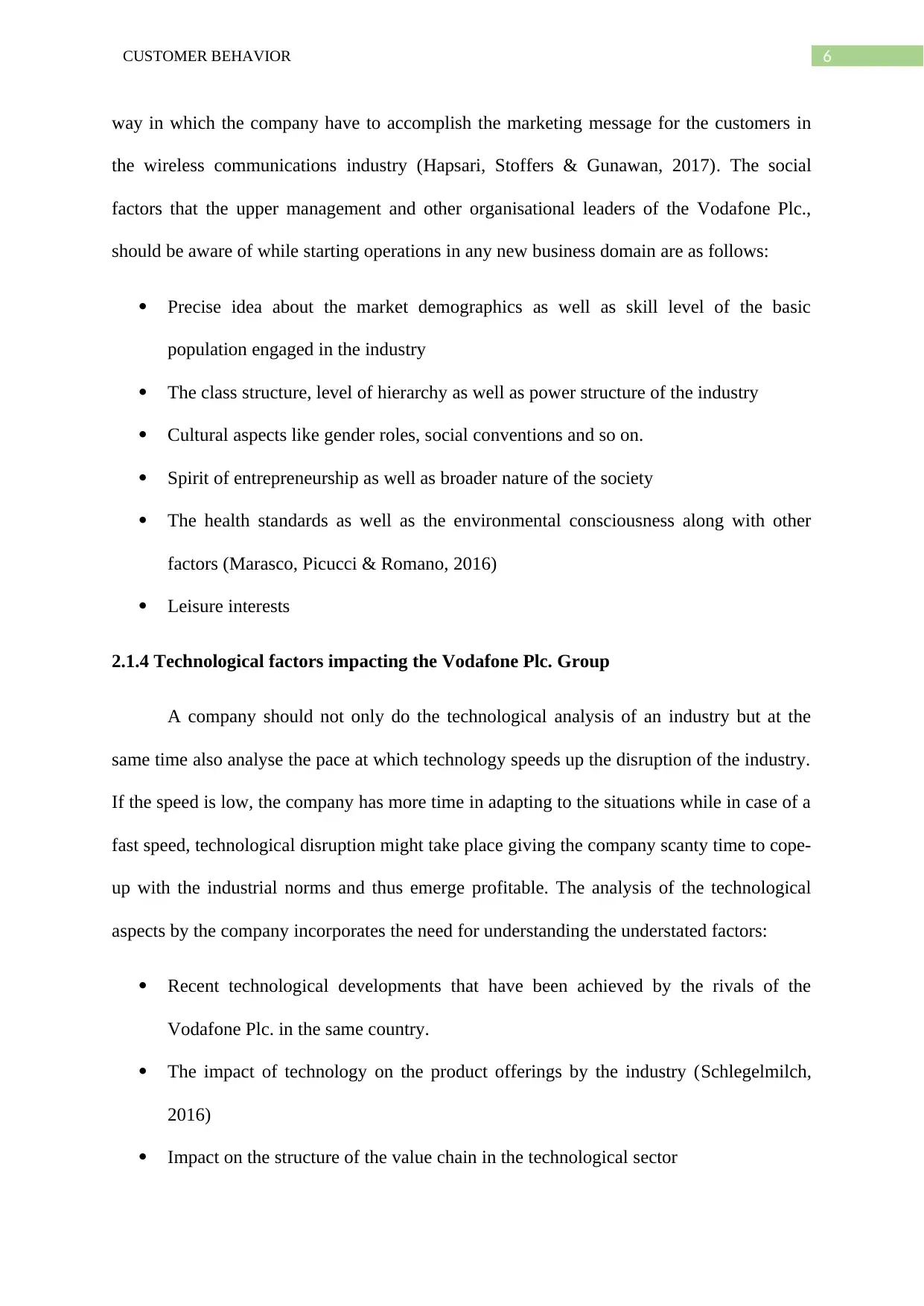
6CUSTOMER BEHAVIOR
way in which the company have to accomplish the marketing message for the customers in
the wireless communications industry (Hapsari, Stoffers & Gunawan, 2017). The social
factors that the upper management and other organisational leaders of the Vodafone Plc.,
should be aware of while starting operations in any new business domain are as follows:
Precise idea about the market demographics as well as skill level of the basic
population engaged in the industry
The class structure, level of hierarchy as well as power structure of the industry
Cultural aspects like gender roles, social conventions and so on.
Spirit of entrepreneurship as well as broader nature of the society
The health standards as well as the environmental consciousness along with other
factors (Marasco, Picucci & Romano, 2016)
Leisure interests
2.1.4 Technological factors impacting the Vodafone Plc. Group
A company should not only do the technological analysis of an industry but at the
same time also analyse the pace at which technology speeds up the disruption of the industry.
If the speed is low, the company has more time in adapting to the situations while in case of a
fast speed, technological disruption might take place giving the company scanty time to cope-
up with the industrial norms and thus emerge profitable. The analysis of the technological
aspects by the company incorporates the need for understanding the understated factors:
Recent technological developments that have been achieved by the rivals of the
Vodafone Plc. in the same country.
The impact of technology on the product offerings by the industry (Schlegelmilch,
2016)
Impact on the structure of the value chain in the technological sector
way in which the company have to accomplish the marketing message for the customers in
the wireless communications industry (Hapsari, Stoffers & Gunawan, 2017). The social
factors that the upper management and other organisational leaders of the Vodafone Plc.,
should be aware of while starting operations in any new business domain are as follows:
Precise idea about the market demographics as well as skill level of the basic
population engaged in the industry
The class structure, level of hierarchy as well as power structure of the industry
Cultural aspects like gender roles, social conventions and so on.
Spirit of entrepreneurship as well as broader nature of the society
The health standards as well as the environmental consciousness along with other
factors (Marasco, Picucci & Romano, 2016)
Leisure interests
2.1.4 Technological factors impacting the Vodafone Plc. Group
A company should not only do the technological analysis of an industry but at the
same time also analyse the pace at which technology speeds up the disruption of the industry.
If the speed is low, the company has more time in adapting to the situations while in case of a
fast speed, technological disruption might take place giving the company scanty time to cope-
up with the industrial norms and thus emerge profitable. The analysis of the technological
aspects by the company incorporates the need for understanding the understated factors:
Recent technological developments that have been achieved by the rivals of the
Vodafone Plc. in the same country.
The impact of technology on the product offerings by the industry (Schlegelmilch,
2016)
Impact on the structure of the value chain in the technological sector
⊘ This is a preview!⊘
Do you want full access?
Subscribe today to unlock all pages.

Trusted by 1+ million students worldwide
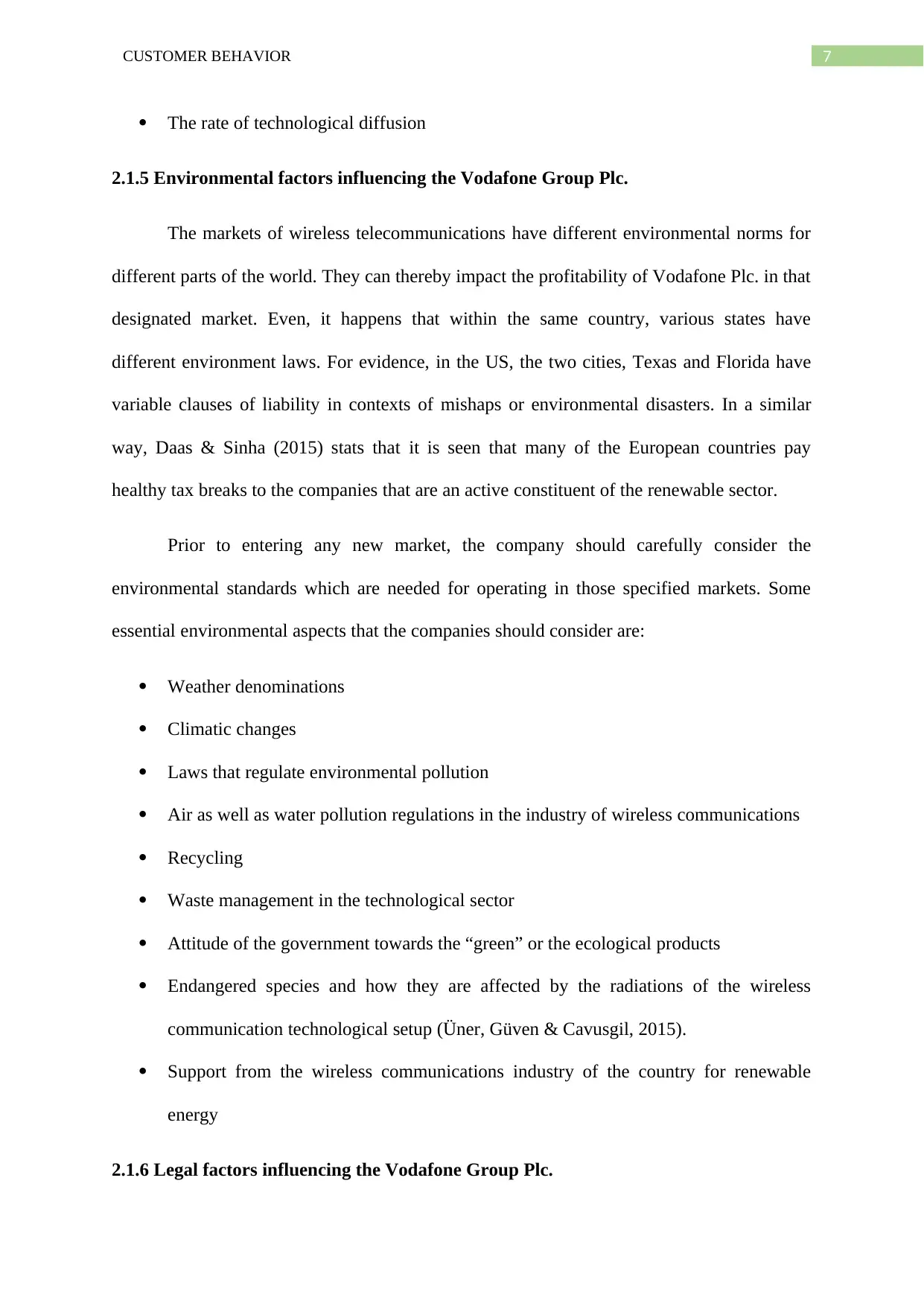
7CUSTOMER BEHAVIOR
The rate of technological diffusion
2.1.5 Environmental factors influencing the Vodafone Group Plc.
The markets of wireless telecommunications have different environmental norms for
different parts of the world. They can thereby impact the profitability of Vodafone Plc. in that
designated market. Even, it happens that within the same country, various states have
different environment laws. For evidence, in the US, the two cities, Texas and Florida have
variable clauses of liability in contexts of mishaps or environmental disasters. In a similar
way, Daas & Sinha (2015) stats that it is seen that many of the European countries pay
healthy tax breaks to the companies that are an active constituent of the renewable sector.
Prior to entering any new market, the company should carefully consider the
environmental standards which are needed for operating in those specified markets. Some
essential environmental aspects that the companies should consider are:
Weather denominations
Climatic changes
Laws that regulate environmental pollution
Air as well as water pollution regulations in the industry of wireless communications
Recycling
Waste management in the technological sector
Attitude of the government towards the “green” or the ecological products
Endangered species and how they are affected by the radiations of the wireless
communication technological setup (Üner, Güven & Cavusgil, 2015).
Support from the wireless communications industry of the country for renewable
energy
2.1.6 Legal factors influencing the Vodafone Group Plc.
The rate of technological diffusion
2.1.5 Environmental factors influencing the Vodafone Group Plc.
The markets of wireless telecommunications have different environmental norms for
different parts of the world. They can thereby impact the profitability of Vodafone Plc. in that
designated market. Even, it happens that within the same country, various states have
different environment laws. For evidence, in the US, the two cities, Texas and Florida have
variable clauses of liability in contexts of mishaps or environmental disasters. In a similar
way, Daas & Sinha (2015) stats that it is seen that many of the European countries pay
healthy tax breaks to the companies that are an active constituent of the renewable sector.
Prior to entering any new market, the company should carefully consider the
environmental standards which are needed for operating in those specified markets. Some
essential environmental aspects that the companies should consider are:
Weather denominations
Climatic changes
Laws that regulate environmental pollution
Air as well as water pollution regulations in the industry of wireless communications
Recycling
Waste management in the technological sector
Attitude of the government towards the “green” or the ecological products
Endangered species and how they are affected by the radiations of the wireless
communication technological setup (Üner, Güven & Cavusgil, 2015).
Support from the wireless communications industry of the country for renewable
energy
2.1.6 Legal factors influencing the Vodafone Group Plc.
Paraphrase This Document
Need a fresh take? Get an instant paraphrase of this document with our AI Paraphraser
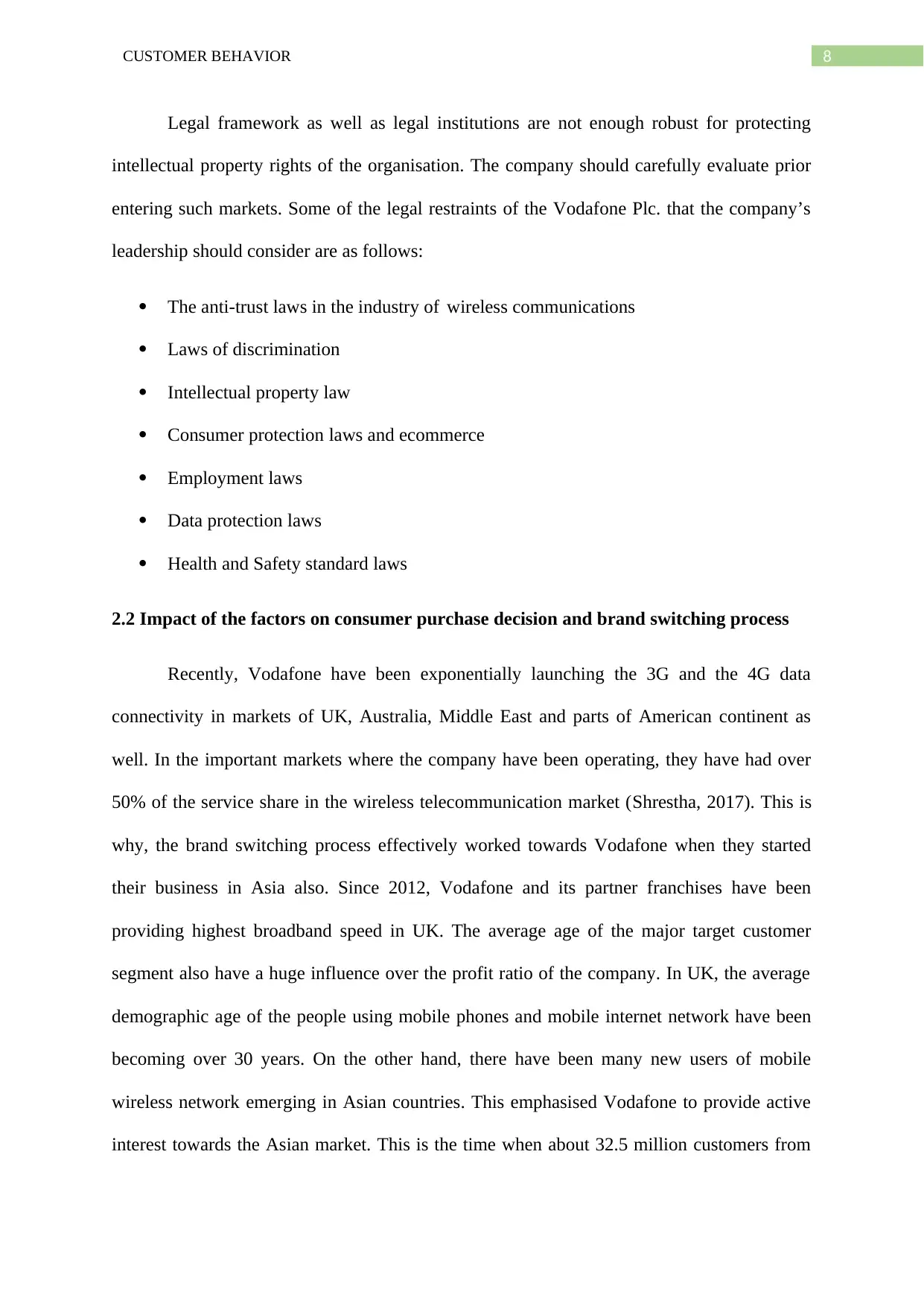
8CUSTOMER BEHAVIOR
Legal framework as well as legal institutions are not enough robust for protecting
intellectual property rights of the organisation. The company should carefully evaluate prior
entering such markets. Some of the legal restraints of the Vodafone Plc. that the company’s
leadership should consider are as follows:
The anti-trust laws in the industry of wireless communications
Laws of discrimination
Intellectual property law
Consumer protection laws and ecommerce
Employment laws
Data protection laws
Health and Safety standard laws
2.2 Impact of the factors on consumer purchase decision and brand switching process
Recently, Vodafone have been exponentially launching the 3G and the 4G data
connectivity in markets of UK, Australia, Middle East and parts of American continent as
well. In the important markets where the company have been operating, they have had over
50% of the service share in the wireless telecommunication market (Shrestha, 2017). This is
why, the brand switching process effectively worked towards Vodafone when they started
their business in Asia also. Since 2012, Vodafone and its partner franchises have been
providing highest broadband speed in UK. The average age of the major target customer
segment also have a huge influence over the profit ratio of the company. In UK, the average
demographic age of the people using mobile phones and mobile internet network have been
becoming over 30 years. On the other hand, there have been many new users of mobile
wireless network emerging in Asian countries. This emphasised Vodafone to provide active
interest towards the Asian market. This is the time when about 32.5 million customers from
Legal framework as well as legal institutions are not enough robust for protecting
intellectual property rights of the organisation. The company should carefully evaluate prior
entering such markets. Some of the legal restraints of the Vodafone Plc. that the company’s
leadership should consider are as follows:
The anti-trust laws in the industry of wireless communications
Laws of discrimination
Intellectual property law
Consumer protection laws and ecommerce
Employment laws
Data protection laws
Health and Safety standard laws
2.2 Impact of the factors on consumer purchase decision and brand switching process
Recently, Vodafone have been exponentially launching the 3G and the 4G data
connectivity in markets of UK, Australia, Middle East and parts of American continent as
well. In the important markets where the company have been operating, they have had over
50% of the service share in the wireless telecommunication market (Shrestha, 2017). This is
why, the brand switching process effectively worked towards Vodafone when they started
their business in Asia also. Since 2012, Vodafone and its partner franchises have been
providing highest broadband speed in UK. The average age of the major target customer
segment also have a huge influence over the profit ratio of the company. In UK, the average
demographic age of the people using mobile phones and mobile internet network have been
becoming over 30 years. On the other hand, there have been many new users of mobile
wireless network emerging in Asian countries. This emphasised Vodafone to provide active
interest towards the Asian market. This is the time when about 32.5 million customers from
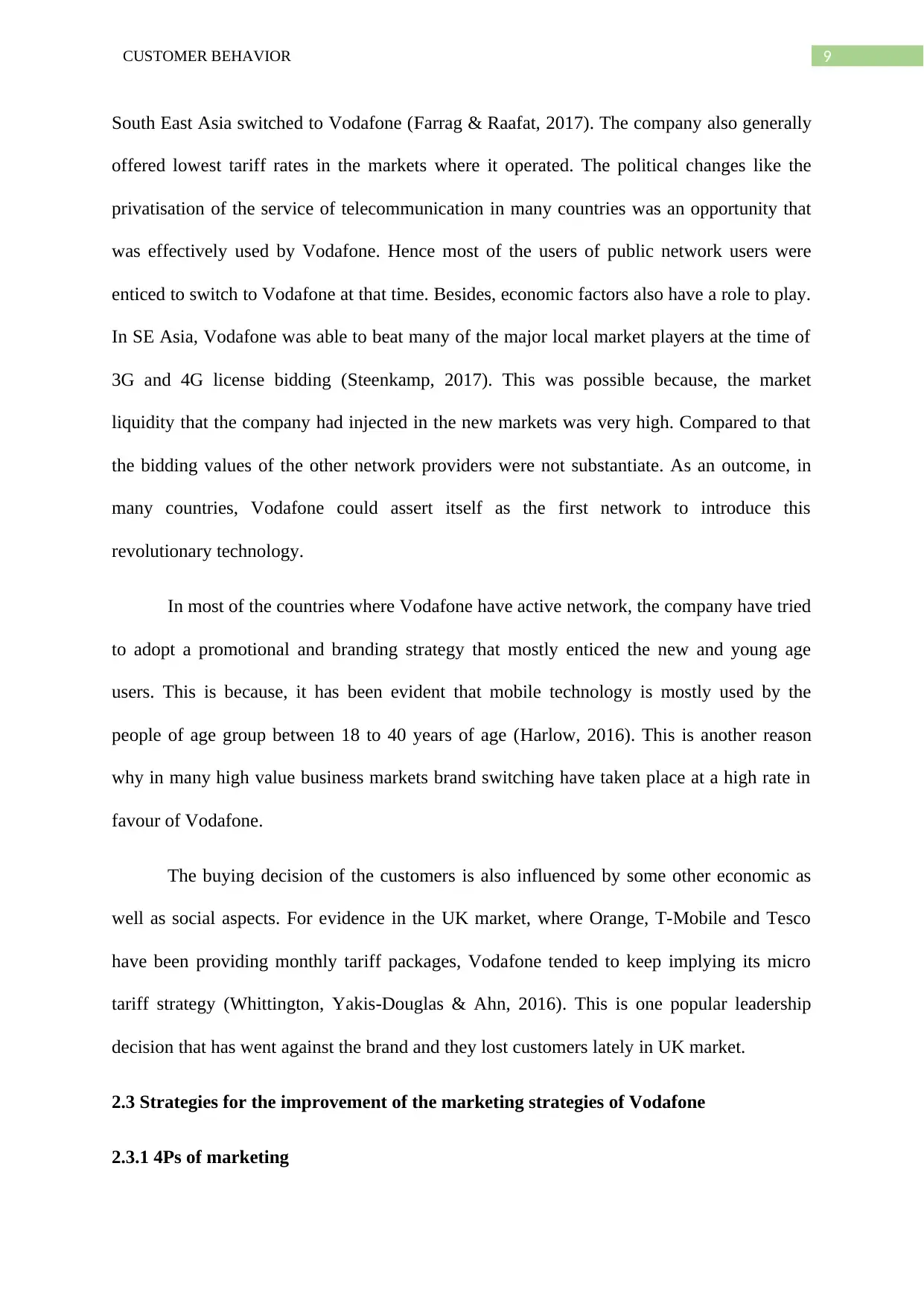
9CUSTOMER BEHAVIOR
South East Asia switched to Vodafone (Farrag & Raafat, 2017). The company also generally
offered lowest tariff rates in the markets where it operated. The political changes like the
privatisation of the service of telecommunication in many countries was an opportunity that
was effectively used by Vodafone. Hence most of the users of public network users were
enticed to switch to Vodafone at that time. Besides, economic factors also have a role to play.
In SE Asia, Vodafone was able to beat many of the major local market players at the time of
3G and 4G license bidding (Steenkamp, 2017). This was possible because, the market
liquidity that the company had injected in the new markets was very high. Compared to that
the bidding values of the other network providers were not substantiate. As an outcome, in
many countries, Vodafone could assert itself as the first network to introduce this
revolutionary technology.
In most of the countries where Vodafone have active network, the company have tried
to adopt a promotional and branding strategy that mostly enticed the new and young age
users. This is because, it has been evident that mobile technology is mostly used by the
people of age group between 18 to 40 years of age (Harlow, 2016). This is another reason
why in many high value business markets brand switching have taken place at a high rate in
favour of Vodafone.
The buying decision of the customers is also influenced by some other economic as
well as social aspects. For evidence in the UK market, where Orange, T-Mobile and Tesco
have been providing monthly tariff packages, Vodafone tended to keep implying its micro
tariff strategy (Whittington, Yakis‐Douglas & Ahn, 2016). This is one popular leadership
decision that has went against the brand and they lost customers lately in UK market.
2.3 Strategies for the improvement of the marketing strategies of Vodafone
2.3.1 4Ps of marketing
South East Asia switched to Vodafone (Farrag & Raafat, 2017). The company also generally
offered lowest tariff rates in the markets where it operated. The political changes like the
privatisation of the service of telecommunication in many countries was an opportunity that
was effectively used by Vodafone. Hence most of the users of public network users were
enticed to switch to Vodafone at that time. Besides, economic factors also have a role to play.
In SE Asia, Vodafone was able to beat many of the major local market players at the time of
3G and 4G license bidding (Steenkamp, 2017). This was possible because, the market
liquidity that the company had injected in the new markets was very high. Compared to that
the bidding values of the other network providers were not substantiate. As an outcome, in
many countries, Vodafone could assert itself as the first network to introduce this
revolutionary technology.
In most of the countries where Vodafone have active network, the company have tried
to adopt a promotional and branding strategy that mostly enticed the new and young age
users. This is because, it has been evident that mobile technology is mostly used by the
people of age group between 18 to 40 years of age (Harlow, 2016). This is another reason
why in many high value business markets brand switching have taken place at a high rate in
favour of Vodafone.
The buying decision of the customers is also influenced by some other economic as
well as social aspects. For evidence in the UK market, where Orange, T-Mobile and Tesco
have been providing monthly tariff packages, Vodafone tended to keep implying its micro
tariff strategy (Whittington, Yakis‐Douglas & Ahn, 2016). This is one popular leadership
decision that has went against the brand and they lost customers lately in UK market.
2.3 Strategies for the improvement of the marketing strategies of Vodafone
2.3.1 4Ps of marketing
⊘ This is a preview!⊘
Do you want full access?
Subscribe today to unlock all pages.

Trusted by 1+ million students worldwide
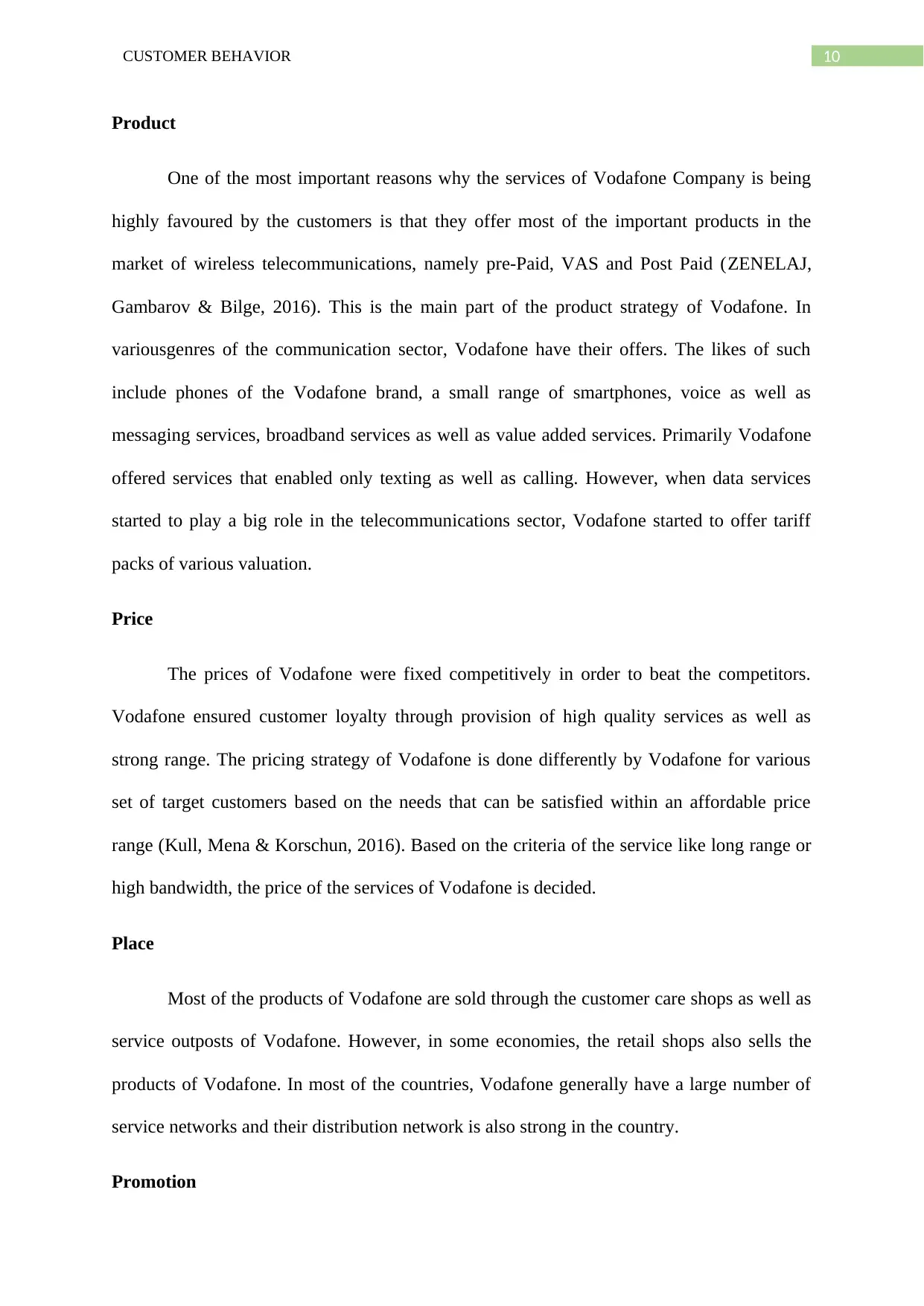
10CUSTOMER BEHAVIOR
Product
One of the most important reasons why the services of Vodafone Company is being
highly favoured by the customers is that they offer most of the important products in the
market of wireless telecommunications, namely pre-Paid, VAS and Post Paid (ZENELAJ,
Gambarov & Bilge, 2016). This is the main part of the product strategy of Vodafone. In
variousgenres of the communication sector, Vodafone have their offers. The likes of such
include phones of the Vodafone brand, a small range of smartphones, voice as well as
messaging services, broadband services as well as value added services. Primarily Vodafone
offered services that enabled only texting as well as calling. However, when data services
started to play a big role in the telecommunications sector, Vodafone started to offer tariff
packs of various valuation.
Price
The prices of Vodafone were fixed competitively in order to beat the competitors.
Vodafone ensured customer loyalty through provision of high quality services as well as
strong range. The pricing strategy of Vodafone is done differently by Vodafone for various
set of target customers based on the needs that can be satisfied within an affordable price
range (Kull, Mena & Korschun, 2016). Based on the criteria of the service like long range or
high bandwidth, the price of the services of Vodafone is decided.
Place
Most of the products of Vodafone are sold through the customer care shops as well as
service outposts of Vodafone. However, in some economies, the retail shops also sells the
products of Vodafone. In most of the countries, Vodafone generally have a large number of
service networks and their distribution network is also strong in the country.
Promotion
Product
One of the most important reasons why the services of Vodafone Company is being
highly favoured by the customers is that they offer most of the important products in the
market of wireless telecommunications, namely pre-Paid, VAS and Post Paid (ZENELAJ,
Gambarov & Bilge, 2016). This is the main part of the product strategy of Vodafone. In
variousgenres of the communication sector, Vodafone have their offers. The likes of such
include phones of the Vodafone brand, a small range of smartphones, voice as well as
messaging services, broadband services as well as value added services. Primarily Vodafone
offered services that enabled only texting as well as calling. However, when data services
started to play a big role in the telecommunications sector, Vodafone started to offer tariff
packs of various valuation.
Price
The prices of Vodafone were fixed competitively in order to beat the competitors.
Vodafone ensured customer loyalty through provision of high quality services as well as
strong range. The pricing strategy of Vodafone is done differently by Vodafone for various
set of target customers based on the needs that can be satisfied within an affordable price
range (Kull, Mena & Korschun, 2016). Based on the criteria of the service like long range or
high bandwidth, the price of the services of Vodafone is decided.
Place
Most of the products of Vodafone are sold through the customer care shops as well as
service outposts of Vodafone. However, in some economies, the retail shops also sells the
products of Vodafone. In most of the countries, Vodafone generally have a large number of
service networks and their distribution network is also strong in the country.
Promotion
Paraphrase This Document
Need a fresh take? Get an instant paraphrase of this document with our AI Paraphraser
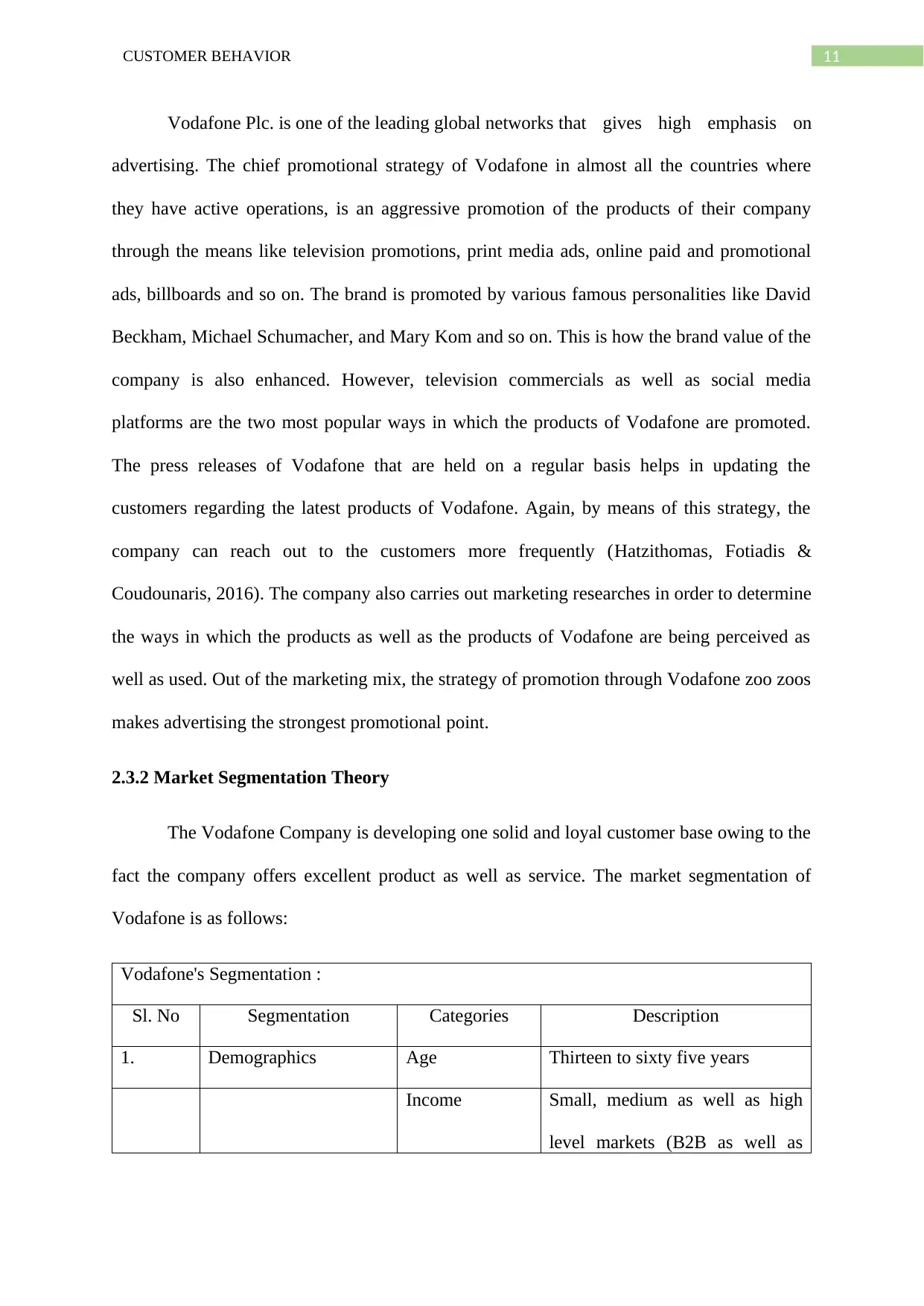
11CUSTOMER BEHAVIOR
Vodafone Plc. is one of the leading global networks that gives high emphasis on
advertising. The chief promotional strategy of Vodafone in almost all the countries where
they have active operations, is an aggressive promotion of the products of their company
through the means like television promotions, print media ads, online paid and promotional
ads, billboards and so on. The brand is promoted by various famous personalities like David
Beckham, Michael Schumacher, and Mary Kom and so on. This is how the brand value of the
company is also enhanced. However, television commercials as well as social media
platforms are the two most popular ways in which the products of Vodafone are promoted.
The press releases of Vodafone that are held on a regular basis helps in updating the
customers regarding the latest products of Vodafone. Again, by means of this strategy, the
company can reach out to the customers more frequently (Hatzithomas, Fotiadis &
Coudounaris, 2016). The company also carries out marketing researches in order to determine
the ways in which the products as well as the products of Vodafone are being perceived as
well as used. Out of the marketing mix, the strategy of promotion through Vodafone zoo zoos
makes advertising the strongest promotional point.
2.3.2 Market Segmentation Theory
The Vodafone Company is developing one solid and loyal customer base owing to the
fact the company offers excellent product as well as service. The market segmentation of
Vodafone is as follows:
Vodafone's Segmentation :
Sl. No Segmentation Categories Description
1. Demographics Age Thirteen to sixty five years
Income Small, medium as well as high
level markets (B2B as well as
Vodafone Plc. is one of the leading global networks that gives high emphasis on
advertising. The chief promotional strategy of Vodafone in almost all the countries where
they have active operations, is an aggressive promotion of the products of their company
through the means like television promotions, print media ads, online paid and promotional
ads, billboards and so on. The brand is promoted by various famous personalities like David
Beckham, Michael Schumacher, and Mary Kom and so on. This is how the brand value of the
company is also enhanced. However, television commercials as well as social media
platforms are the two most popular ways in which the products of Vodafone are promoted.
The press releases of Vodafone that are held on a regular basis helps in updating the
customers regarding the latest products of Vodafone. Again, by means of this strategy, the
company can reach out to the customers more frequently (Hatzithomas, Fotiadis &
Coudounaris, 2016). The company also carries out marketing researches in order to determine
the ways in which the products as well as the products of Vodafone are being perceived as
well as used. Out of the marketing mix, the strategy of promotion through Vodafone zoo zoos
makes advertising the strongest promotional point.
2.3.2 Market Segmentation Theory
The Vodafone Company is developing one solid and loyal customer base owing to the
fact the company offers excellent product as well as service. The market segmentation of
Vodafone is as follows:
Vodafone's Segmentation :
Sl. No Segmentation Categories Description
1. Demographics Age Thirteen to sixty five years
Income Small, medium as well as high
level markets (B2B as well as
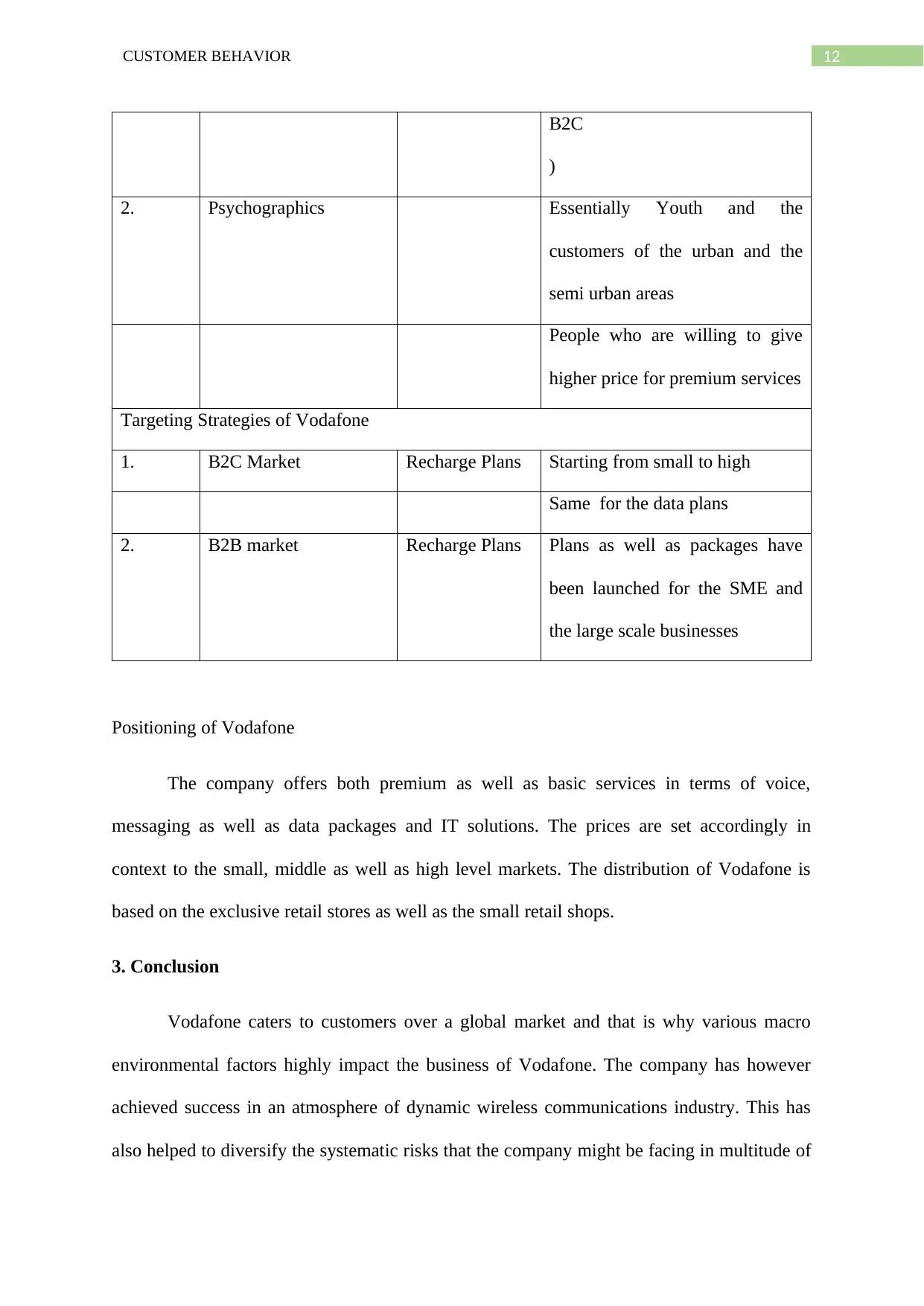
12CUSTOMER BEHAVIOR
B2C
)
2. Psychographics Essentially Youth and the
customers of the urban and the
semi urban areas
People who are willing to give
higher price for premium services
Targeting Strategies of Vodafone
1. B2C Market Recharge Plans Starting from small to high
Same for the data plans
2. B2B market Recharge Plans Plans as well as packages have
been launched for the SME and
the large scale businesses
Positioning of Vodafone
The company offers both premium as well as basic services in terms of voice,
messaging as well as data packages and IT solutions. The prices are set accordingly in
context to the small, middle as well as high level markets. The distribution of Vodafone is
based on the exclusive retail stores as well as the small retail shops.
3. Conclusion
Vodafone caters to customers over a global market and that is why various macro
environmental factors highly impact the business of Vodafone. The company has however
achieved success in an atmosphere of dynamic wireless communications industry. This has
also helped to diversify the systematic risks that the company might be facing in multitude of
B2C
)
2. Psychographics Essentially Youth and the
customers of the urban and the
semi urban areas
People who are willing to give
higher price for premium services
Targeting Strategies of Vodafone
1. B2C Market Recharge Plans Starting from small to high
Same for the data plans
2. B2B market Recharge Plans Plans as well as packages have
been launched for the SME and
the large scale businesses
Positioning of Vodafone
The company offers both premium as well as basic services in terms of voice,
messaging as well as data packages and IT solutions. The prices are set accordingly in
context to the small, middle as well as high level markets. The distribution of Vodafone is
based on the exclusive retail stores as well as the small retail shops.
3. Conclusion
Vodafone caters to customers over a global market and that is why various macro
environmental factors highly impact the business of Vodafone. The company has however
achieved success in an atmosphere of dynamic wireless communications industry. This has
also helped to diversify the systematic risks that the company might be facing in multitude of
⊘ This is a preview!⊘
Do you want full access?
Subscribe today to unlock all pages.

Trusted by 1+ million students worldwide
1 out of 16
Related Documents
Your All-in-One AI-Powered Toolkit for Academic Success.
+13062052269
info@desklib.com
Available 24*7 on WhatsApp / Email
![[object Object]](/_next/static/media/star-bottom.7253800d.svg)
Unlock your academic potential
Copyright © 2020–2025 A2Z Services. All Rights Reserved. Developed and managed by ZUCOL.



